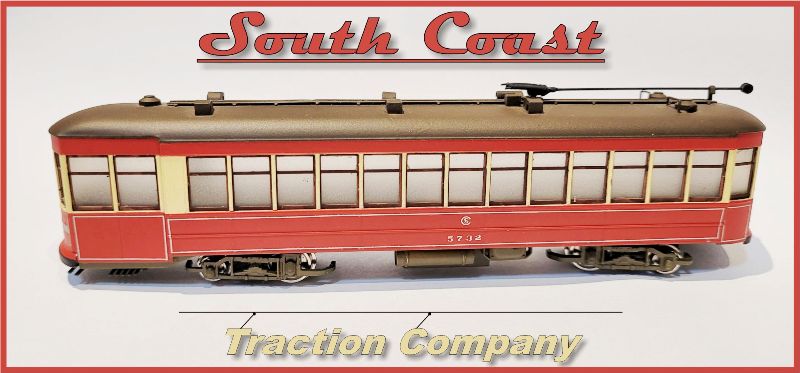One of the key factors in the layout design has been the unexpected purchase of an Electroliner set recently. It was too nice to let it go and I immediately purchased it. This rush of blood made me realise that the whole lot of previous planning of a layout with just trolley cars was now altered. As this set is made up of four articulated cars you could almost call it a train. But in real life most of its journey between Chicago and Milwaukee was on a railway like right of way where very high speeds were attained. But at the other end of its operation it was also able to negotiate street trackage and elevated systems and sharp curves to get to the terminus. It was the sharp curve situation that was going to effect me in the layout design.
Prior to sending the unit away for a decoder fitout I read that the unit was suitable for ten inch radius curves, so I promptly set out making paper templates, cutting them out and laying them all over the layout to try and find a final design.
Oh for some overhead
The Electroliner was the first unit that I required to be decoder fitted as this was going to set the minimum radius curve size. I still had that magic ten inch figure that I was hoping for. Late last week I got notification that the decoder had been fitted and it was ready for collection. Last Saturday was the day and luckily it coincided with a model railway exhibition where I was able to receive it. It was also fitted out with a sound decoder which compared with either a diesel or steam sound decoder I must admit sounds pretty boring. Sometimes you felt that even before it was fitted out it was already making a similar sound with the existing motor! Anyway it has been done and has a nice horn and compressor sounds. And also the two bells which I presume is some sort of conductor communiciation with the motorman. Coupled with the head and tail lights it has come out well.
One bit of feedback I got from the person fitting the decoder was the difficulty of removing the body from the chassis to do the work. There seems to be two items the body and the window section that have to coordinate being able to be released together. This was made more difficult for him as apparently it seems like the windows and body sides were assembled before the paint had dried and getting them to release wasn't an easy job, thanks John for your careful persistance. When I received my first locos when there was only one number in my age, the Tri-ang loco bodies were just held on with a screw, so simple but it worked and was so much easier. These days it seems it is pot luck what bit you push or pull to get the bodies off.
I was running it on my sons layout to see how it performed and I am pleased with the end result. This is one very smooth unit. Having had some fun letting it stretch its legs (the driver probably thought he was on his way to Milwaukee!) it was time to test the minimum radius curves. I had made up a ten inch template and then had a section of flex track bent around into a short section for testing. As soon as I hooked up the DCC the sound unit came on. At least the driver seemed to be ready. I slowly inched up the throttle to number one on the dial and it slowly moved around the bend. But unfortunately it had derailed a couple of tiimes so I was ready to declare the ten inch test a failure. Now I had read on Facebook after I had posed the ten inch curve question that by modifying the diaphragms or adding some weight underneath this could solve the problem. I thought that I would choose to step up and go to an eleven inch radius curve and use this as the basic minimum curve for the whole layout. I am sure traction modellers have a laugh at rail modellers when they say they can go around eighteen inch radius - hey try traction land where we can do an eight inch curve!.
It was a case of back to the drawing board and make the next one up - an eleven inch radius template. Eventually I made up something that looked like it would work. The track laid was taken up and reconfigured to an around eleven inch curve. So after getting it all ready, controller hooked up, unit on track it was tried out and after about ten trips back and forward it was deemed a success resulting in nil derailments.
The failed 10" radius
 |
| Successful eleven inch curve |


Good story Bob. Easing the minimum radius of 11" seems a good compromise to get the electroliner to run.
ReplyDelete